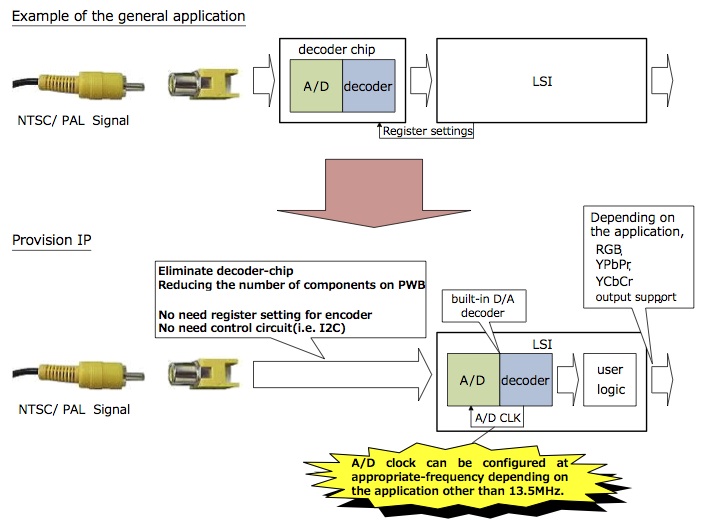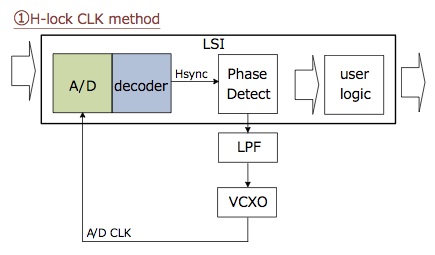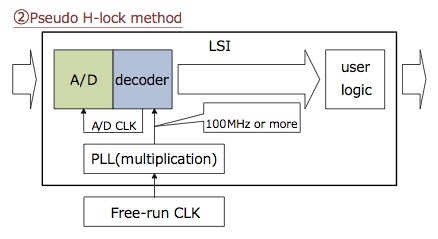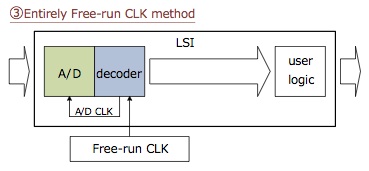NTSC/PAL digital video decoder
Our NTSC/PAL digital video decoder can be deliverer whatever customizing flexibly in accordance with the priority of customer requirements
(such as image quality, functionality and area size).
This allows you to reduce the cost drastically and/or shorten the development cycle in the case of LSI development integrating with other peripherals.
NTSC/PAL composite or S-video signals are converted to Y/Cb/Cr or RGB digital video signals.

NTSC/PAL digital video decoder offers the following three methods for generating A/D CLK.
These three methods are possible to use in combination also, customer can determine the method depending on the purpose of use.

HSYNC detector and Phase Detector are integrated into the ASIC circuit. However, you must deploy an external VCXO and LPF(Low Pass Filter).
Reference design is available..
Features
・For standard signal (even noisy signal but Hsyncs are aligned originally), you can get the best performance.
・Even for tuner output under weak radio condition (quite noisy signal but still it is standard signal), stable the output can be obtained until tuner mostly loses the signal. By this reason, many of automotive TV systems have adopted this method.
・For Non-standard signals (Hsync signal with large disturbance) such as a VCR playback signal, this method is not applicable.
・Neither output of Hsync or Vsync hold any disorder.
・With processing the R/G/B or Y/Cb/Cr signal obtained in this method, you can get a standard NTSC/PAL signal through encoder again.
・Even if some CLK noise is riding on the A/D input signal, the resulting output is not affected. Therefore, you can design analog section of PWB relatively easily.

Free-run clock is applied for ASIC clock source.
This method generates high speed (100MHz or above) CLK by a PLL deployed in ASIC from the free-run CLK source, and then generates pseudo synchronized CLK with H-sync as the A/D CLK.
Features
・Good decode performance almost close to H-lock CLK method previously described is achievable as long as H-sync can be detected form A/D output nevertheless standard or not-standard video signals.(This is suitable either for DSC, DVD or tuner output signal except for weak radio condition.)
・The time of H length varies +/-1CLK in several dozens of lines on output. This doesn’t a matter as it is for output to LCD panel, however this accumulated time skew must be compensated at a V blanking line if the output is sourced to CRT monitor or re-encoded to NTSC or PAL video though an encoder. In that case, an additional dual port memory 10bit(8bit)×128〜1024 is required.
・Re-encoded signal which is made from R/G/B or Y/Cb/Cr output by this method to NTSC or PAL must be non-standard signal. (The continuity of the burst signal is kept, however it contains a line which does not match to the standard length. A frame buffer is required to comply with standard signal.)
・It must be careful to prevent from free-run CLK noise interference to A/D input in PWB design phase, even though this method can achieve good performance close to the orthodox H-lock clock method. If free-run CLK interferes to A/D input, horizontal strips may appear on all over the screen.

Free-run CLK is applied to ASIC source.
Input free-run CLK is used directly. The output contains CLK jitter if nothing done, however the IP does the compensation operation so that CLK jitter disappears even in this method.
Features
・Any video signal can be decoded as long as H-sync can be detected form A/D output, regardless of standard or not-standard video signal.
・The time of H length varies +/-1CLK in several dozens of lines on output. This doesn’t a matter as it is for output to LCD panel, however this accumulated time skew must be compensated at a V blanking line if the output is sourced to CRT monitor or re-encoded to NTSC or PAL video though an encoder.
In that case, 3 additional dual port memories 10bit(8bit)×128〜1024 are required.
・Re-encoded signal which is made from R/G/B or Y/Cb/Cr output by this method to NTSC or PAL must be non-standard signal. (The continuity of burst signal is kept but it contains a line which does not match to the standard length. A frame buffer is required to comply with standard signal.)
・Comb-filter could be applicable even on this method, however you might see the problem that the shading generated by higher frequency component (above 3MHz) drifts up and down if comb-filter is applied. This problem can be resolved by disabling Comb-filter or eliminating the higher frequency component on Y signal. This must be sufficient for low resolution display panel (such as 320dots horizontal resolution or less).
・WB design in analog area would be relatively easy since CLK noise interference to A/D input does not affect to the decoder output so much.